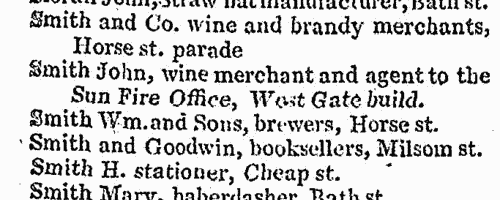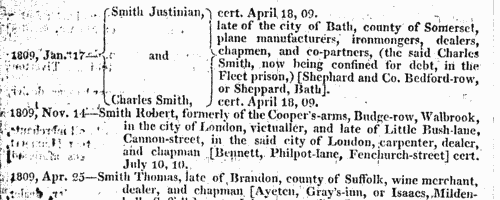Our indexes include entries for the spelling stimson. In the period you have requested, we have the following 153 records (displaying 41 to 50):
 Apprentices and clerks
(1800) Apprentices and clerks
(1800)
Apprenticeship indentures and clerks' articles were subject to a 6d or 12d per pound stamp duty: the registers of the payments usually give the master's trade, address, and occupation, and the apprentice's name, as well as details of the date and length of the apprenticeship. 2 January to 31 December 1800. IR 1/38 | Sample scan, click to enlarge

|
 Masters of apprentices and clerks
(1800) Masters of apprentices and clerks
(1800)
Apprenticeship indentures and clerks' articles were subject to a 6d or 12d per pound stamp duty: the registers of the payments usually give the master's trade, address, and occupation, and the apprentice's name, as well as details of the date and length of the apprenticeship. 2 January to 31 December 1800. IR 1/38 | Sample scan, click to enlarge

|
 Masters of apprentices and clerks
(1801) Masters of apprentices and clerks
(1801)
Apprenticeship indentures and clerks' articles were subject to a 6d or 12d per pound stamp duty: the registers of the payments usually give the master's trade, address, and occupation, and the apprentice's name, as well as details of the date and length of the apprenticeship. 2 January to 31 December 1801. IR 1/38 | Sample scan, click to enlarge

|
Rutland Cottagers: Langham
(1801)
Robert Gourlay published the results of a detailed survey that he had made in person travelling from village to village in Lincolnshire and Rutland, examining the state of the cottagers in each parish. After a general description of the local agriculture, he listed the cottagers by name, and, where possible, recorded the acreage of their holdings, annual rent, the number of persons in each family, and their stock, giving numbers of cows, pigs, horses &c. | Sample scan, click to enlarge

|
 Masters of apprentices and clerks
(1804) Masters of apprentices and clerks
(1804)
Apprenticeship indentures and clerks' articles were subject to a 6d or 12d per pound stamp duty: the registers of the payments usually give the master's trade, address, and occupation, and the apprentice's name, as well as details of the date and length of the apprenticeship. 2 January to 31 December 1804. IR 1/39 | Sample scan, click to enlarge

|
Inhabitants of Cambridge
(1805)
Holden's Triennial Directory of 1805 to 1807 included a provincial section, listing professional people and traders in England, Wales, Scotland and Ireland. (The sample scan here is from the listing for Bath) | Sample scan, click to enlarge

|
Traders and professionals in London
(1805)
Holden's Triennial Directory for 1805 to 1807 includes this 'London Alphabet of Businesses, Professions, &c.': coverage is good; about 30,000 individuals are recorded. | Sample scan, click to enlarge

|
Bankrupts
(1808-1810)
William Smith's abstracts of bankruptcies for England and Wales from 1 January 1808 to 1 August 1810. Bankruptcy causes abrupt changes in people's lives, and is often the reason for someone appearing suddenly in a different location or in a different occupation. | Sample scan, click to enlarge

|
Bankrupts and solicitors
(1810)
English bankrupts and their solicitors, as reported in the European Magazine. July to December 1810.
| Sample scan, click to enlarge

|
London Traders
(1814)
The fifteenth edition of The Post-Office Annual Directory includes this 'List of More than 17,000 Merchants, Traders, &c. of London, and Parts Adjacent', arranged alphabetically by surname, with trade in italics, and address. | Sample scan, click to enlarge

|
Research your ancestry, family history, genealogy and one-name study by direct access to original records and archives indexed by surname.












